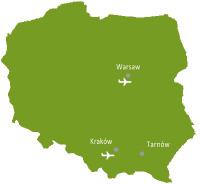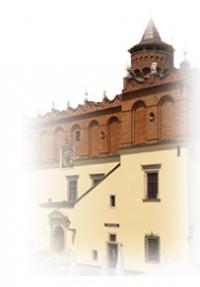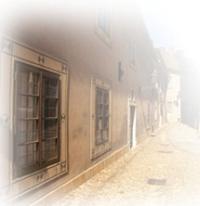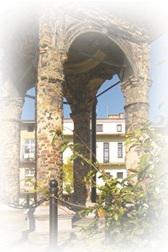![]() Tarnów is located in the southeastern part of Poland 80 km from Kraków. Tarnów has a convenient access to Kraków airport (there is a frequent train connection from Tarnów to Kraków-Balice airport). From 1975 to 1998 Tarnów was the capital city of the region. Today Tarnów is populated by 120 thousand inhabitants. There are three universities in Tarnów with the total number of 15 thousand students.
Tarnów is located in the southeastern part of Poland 80 km from Kraków. Tarnów has a convenient access to Kraków airport (there is a frequent train connection from Tarnów to Kraków-Balice airport). From 1975 to 1998 Tarnów was the capital city of the region. Today Tarnów is populated by 120 thousand inhabitants. There are three universities in Tarnów with the total number of 15 thousand students.
History
 Tarnów is a beautiful town with an outstanding history dating back to XI century. According to the history of the whole city of Tarnów, the nearby St. Martin’s Hill used to be the cradle of Tarnów settlement. From the middle of IX century to the beginning of XI century prevailing town covered the area of about 10 hectares. It was probably a tribal town of Wiślanie, which was ruined during the first Piasts' monarchy in the 30s of XI century. In XV century a famous writer Jan Długosz gave Tarnów its name from the name of bushes, called 'tarnina' (Eng. blackthorn) which plentifully grew the slopes of the St. Martin’s Hill. The Prince of Kujawy, Władysław Łokietek searching support among the Małopolska region elites influenced them significantly. People, so far politically unknown, were given power in return for the unlimited loyalty to the new ruler. It was Mr Spycymir – the later owner of Tarnów – who made career this way. He built his abode, the castle on the St. Martin’s Hill, in 1331.
Tarnów is a beautiful town with an outstanding history dating back to XI century. According to the history of the whole city of Tarnów, the nearby St. Martin’s Hill used to be the cradle of Tarnów settlement. From the middle of IX century to the beginning of XI century prevailing town covered the area of about 10 hectares. It was probably a tribal town of Wiślanie, which was ruined during the first Piasts' monarchy in the 30s of XI century. In XV century a famous writer Jan Długosz gave Tarnów its name from the name of bushes, called 'tarnina' (Eng. blackthorn) which plentifully grew the slopes of the St. Martin’s Hill. The Prince of Kujawy, Władysław Łokietek searching support among the Małopolska region elites influenced them significantly. People, so far politically unknown, were given power in return for the unlimited loyalty to the new ruler. It was Mr Spycymir – the later owner of Tarnów – who made career this way. He built his abode, the castle on the St. Martin’s Hill, in 1331.
It was in the year 1330 that the King’s Office issued greaseproof document, affixed with the King’s seal to the Cracow governor. It was the symbol of King Władysław’s privilege, which entitled Spycymir to locate the city on German norms, such as Cracow. The climax of the hill was reserved for building of a church with the graveyard. In the very center of the hill, a square was traced, with two crossing streets coming out of its every corner. First of all , the location of Tarnów, apart from mapping out squares and grids, was to populate the area. Next to local residents, there were settlers brought from Krakow and Nowy Sącz by Spycymir and his successors. Quite often they were of German origin who quickly became Polonised.
 Historical sites
Historical sites
- Town Hall – originating from XVI century. An inscription curved into stone in Latin: „Let your access and exit be guarded by the God”. It is a rectangular building with the tower facing north and the staircase facing south. It was topped with not plastered attic. The height of the walls from the top of the attic is 18 meters, and the tower is as much as 30 meters high. They used bricks for building. There is a Local Museum inside the Town Hall.
- The Marketplace – Spacious square around the Town Hall, and many narrow and mysterious streets nearby. Due to the level differences you need to mount up the stairs, get through the old gates, tread on the worn out cobbled roads in order to reach the market place. The picturesque view is implemented by arcades, ornamentally wrought gates, historic doors with curled hinges, shutters and flowery balconies. These extraordinary period houses are surrounding the market place.
- Cathedral – the most representative monuments of Tarnów. Cathedral has been rebuilt many times. In its original gothic style shape it was one – nave building with no towers. Between the end of XIV and XIX century the original structure of the building was surrounded by temples. Probably at the end of XV century a huge tower was added from the west side of the nave. Today cathedral?s neo-gothic style was created by thorough renovation and partial rebuilding at the end of XIX century. The sanctuary is famous for its renaissance-style tombstones of Tarnowscy and Ostrogscy families. The tombstones made by Bartłoniej Berecci, Jan Maria Padovano and Jan Pfister are considered to be the finest exponents of arts in Poland.
- Diocesan Museum and Mikołajowski House. Mikołajowski House of gothic – renaissance style (opposite the main entrance to the Cathedral) , bui
 lt in 1524 in Katedralna street is considered to be the oldest house in Tarnów. It contains gothic portals and window frames. Diocesan Museum is located in XVI century historic houses nearby the cathedral. The museum consists of the following buildings: former Academiola, Mikołajowski House, Mansjonariusze House and the building of Scholasticism. The houses constitute the enchanting corner of the Old Town from the west side of the cathedral. There are collections of Diocesan Museum in their interiors. The most important are exhibits of guild arts, gothic style sculpture and painting from Małopolska region.
lt in 1524 in Katedralna street is considered to be the oldest house in Tarnów. It contains gothic portals and window frames. Diocesan Museum is located in XVI century historic houses nearby the cathedral. The museum consists of the following buildings: former Academiola, Mikołajowski House, Mansjonariusze House and the building of Scholasticism. The houses constitute the enchanting corner of the Old Town from the west side of the cathedral. There are collections of Diocesan Museum in their interiors. The most important are exhibits of guild arts, gothic style sculpture and painting from Małopolska region.
- Town fortification – the XVI century embankments, walls and guns surrounding the town for its safety. Only fragments preserved in different parts of Tarnów are in total several meters long, after all they were originally over 900 meters long. Some wall fragments are very well preserved but for example after Pilzneńska Gate, only its name remained. On the other hand Krakowska Gate totally disappeared. But the fact of existence of walls, gates and wickets show that the town had completely different structure than it has today. We can say that it was a property of considerable dimensions, surrounded by a solid 'fence' and guarded entrances. We can say that every access to and exit from the city were monitored. According to the historians in the second half of XVII century Ulryk from Verdum described Leliwas town in his notes: „Tarnów is a well-shaped town, it has embankments, there is a wall with bastions and towers at the top, all surrounded by a moat”.
- Jewish Tarnów and Bima. Bima is a very special place in Tarnów. There used to be synagogue here, today there are only fragments whic
 h survived the fire. There is Rybny Square on the left side of Bima and Żydowska street on the right. This is the place where the time stopped both for Polish Tarnów citizens and Jewish Tarnów citizens. This common history having lasted for 5 centuries was brutally discontinued by the war. In November 1939 Germans set fire to the most synagogues in Tarnów. At the end of 1941 the first mass executions took place in Tarnow. Mass deportation to the death camps started. Three and a half thousand people were sent to Bełżec. In the streets near Marketplace three thousand Jews were executed. In Zbylitowska Góra in Buczyna forest 6 thousand elderly people and kids were murdered. They were buried on spot. In that place there is a monument commemorating the murder. In 1943 the last deportations to death camps in Płaszowice took place, a year later Germans described Tarnów as a town without Jews. Historians assess that out of 40 thousand Jewish citizens living in Tarnów only three thousand survived.
h survived the fire. There is Rybny Square on the left side of Bima and Żydowska street on the right. This is the place where the time stopped both for Polish Tarnów citizens and Jewish Tarnów citizens. This common history having lasted for 5 centuries was brutally discontinued by the war. In November 1939 Germans set fire to the most synagogues in Tarnów. At the end of 1941 the first mass executions took place in Tarnow. Mass deportation to the death camps started. Three and a half thousand people were sent to Bełżec. In the streets near Marketplace three thousand Jews were executed. In Zbylitowska Góra in Buczyna forest 6 thousand elderly people and kids were murdered. They were buried on spot. In that place there is a monument commemorating the murder. In 1943 the last deportations to death camps in Płaszowice took place, a year later Germans described Tarnów as a town without Jews. Historians assess that out of 40 thousand Jewish citizens living in Tarnów only three thousand survived.
- Big Stairs – walking up the big stairs on the left side down the street we can see the most popular local vanity fair. The place has many traditions because in XIV century the junction of Hungarian routes was created here. The route leading to Hungary went through Tarnowiec, Tuchów, Ciężkowice and Grybów to Bardejów. From XV century Tarnów used the rule of storage, which ordered the traders and other travelers to cross Tarnów on their way to and from Hunagry. The traveling traders were obliged to stop in the city for a while and display their goods for sale. It made nearby residents come to the city for shopping. Trader had to eat something and sleep somewhere so Tarnów was developing at that time. From gild documents we learn that craft in Tarnów had a local character. The local trade was in hands of families of Hungarian, German and 15 Scottish origin. We can see that 500 years before European integration the town had international character and foreigners settled here. When we come up the stairs to the marketplace and when we turn around we would see part of St. Martin’s hill. There are ruins of the castle on this hill.
But not only in the old days was Tarnów a prominent place. The town has its lively atmosphere with many cultural events for young people to enjoy. Films, musical and theatrical festivals, unusual open air events, free concerts including are organised on the Market Square – the very heart of the town.
Places and cultural events
- The local Ludwik Solski Theatre offers plays prepared by a professional group of actors, casts and gifted artists. On Sunday mornings in the Tarnów Town Hall „Poetry Salons”, concerts and meetings with writers are organised. The Theatre also takes care of the arrangements of the consecutive National Talia Comedy Festival.
- City Gallery BWA is the place where contemporary art, both Polish and foreign, is displayed. Nearly thirty exhibitions, presentations and artistic events are ogranised each year. It is in Tarnów that world known contemporary artist Wilhelm Sasnal was born. His works can also be admired in galleries displayed in the United States, Paris, London.
- Tarnów Culture Centre is known for organizing Tarnów Film Award – festival of the best Polish movies. It is second, after the festival in Gdynia, such event in Poland. The best film is awarded the figure of Lelivita, however the audience also gives their own prize – Maszkaron figure.
- At the invitation of TCK Jazz Club every month the best jazz players perform in Tarnów. In TCK school of rock music functions as one of the few schools in Poland.
- In Marzenie cinema within the framework of „The fourth extra movie” good and ambitious films are projected.
- Tarnów is often visited by the stars of classical music who perform in the concerts arranged by Paderewski Centre in Kąśna Dolna. Young artists who begin their musical career are granted 'ticket to fame' during Talents' Week.
- Night life can been joyed in Wall Street Bull and Alfa , elegant and fashionable night clubs with good popular music and good and friendly atmosphere.
 Wirtualny Dziekanat
Wirtualny Dziekanat 

